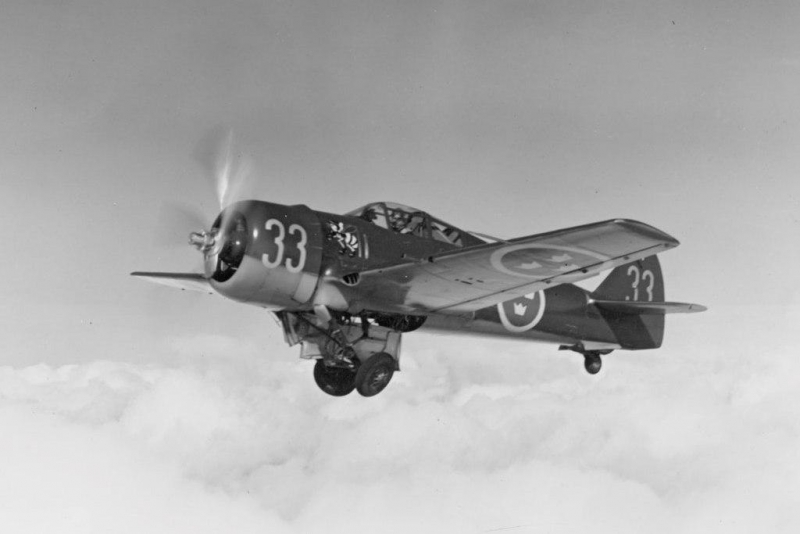Pilots and gentlemen, let me present the FFVS J-22A and B.

Model: FFVS J-22A and B (also known as J22-1 and 2)
Technical Description: Steel and wooden fighter plane with a swedish copy of the P&W twin wasp engine. It is the only Swedish military ww2 plane not made by Saab. It was manufactured by Flygförvaltningens Flygverkstad Stockholm "FFVS" which was a company put together by the Swedish air force just to produce the J-22.
Visual Aspects:


J-22a in see through.

Landing gear going up

Short History: The J-22 was ordered by the Swedish air force as an emergency fighter because Sweden didn't have a modern fighter in 1941. The development was rapid and the aircraft went from prototype to service withing a year.
Configuration: Single seat Fighter
Production Status
First flight: 20 September 1942
Introduction year: 1943
Status: Retired
Number built: 198-200 (different sources)
Crew Data
Number of crew: 1
Roles of crew: Pilot
Engine Data (Piston Aircraft)
Manufacturer: Svenska Flygmotor AB, Trollhättan
Name: STWC-3 (Swedish copy of P&W twin wasp R-1830-SC3-G)
Number of engines: 1
Number of cylinders: 14
Configuration: Radial
Cooling: Air
Supercharger / Turbo: Mechanical compressor.
Fuel: 87 octane
Dry weight: 657.70894 kg
Gear ratio: 2550 rpm
Compression ratio: 6,7: 1
Horsepower: 1050 - 1065 hp
Fuel Data
Fuel: 525 liter
Fuel tanks: One in each wing and one in the body behind the pilot. (09-2)
Wing tanks holds 190 liters each. (09-2)
Body tank holds 145 liter which 140 liters is fuel. (09-2)
Fuel tanks.

Fuel system (now with translations)

Fuel consumption
Air time: 1.4 h 1.3 h 3.2 h 2.7 h
Distance: 620 km 700 km 1320 km 1360 km
Speed: max(mission) max(mission) cruising cruising
Height: 0 m 4300 m 0 m 4300 m
Liter/h: 375 liter 379 liter 160 liter 190 liter
Kg/h: 280 kg 290 kg 120 kg 140 kg
Power Data
WEP:
Take Off Power: 1050 hp (2700 rpm)
Hp max - not Take off: 900 hp (2550 rpm) at 3658 meters
Maximum power: 1 065 hp (749 kW)
Cruising Power: 650 hp (2250 rpm)
Propellor Data
Manufacturer: Svenska Flygmotor AB, Trollhättan
Type: SFA Hamilton VP2-M
Number of blades: 3
Original designation: 3E50-E2270
Blade diameter: 3.10 m
Blade type: A-918-4
Basic Geometric Data
Length: 7.8 m
Height: 2.8 m (3,6 m with landing gear)
Wing span: 10 m
Wing area: 16 m²
Flap area:
Elevator area:
Rudder area:
Aileron area:
Weight Data
Normal weight (mission): J-22A (2760 kg) J-22B (2835 kg)
Normal weight (transfer): J-22A (2660 kg) J-22B (2710 kg)
Empty weight: J-22A (2000 kg) J-22B (2020 kg)
Added weight total (mission): J-22A (750 kg) J-22B (813 kg)
Added weight total (transfer): J-22A (659 kg) J-22B (688 kg)
Added weight
Loose equipment (mission): J-22A (134 kg) J-22B (163 kg)
Loose equipment (transfer): J-22A (146 kg) J-22B (175 kg)
Pilot: 100 kg both
Ammunition: J-22A (111 kg) J-22B (137 kg)
Fuel, wing tanks: 282 kg both
Fuel, body tank: 100 kg both
Oil: 31 kg both
General Performance Data
Maximum speed: 575 km/h at 3500 m
Landing speed: 140 km/h
Cruising speed: 440 km/h
Stall speed: 81 km/h
Rate of climb: 15.5 m/s
Service ceiling: 9300 m
Range: 1270 km
Max Speed Chart
480 km/h at 0 m
575 km/h at 3500 m
560 km/h at 4300 m
Practical fighting speed
420 km/h at 0 m
510 km/h at 4000 m
Cruising speed
410 km/h at 0 m
500 km/h at 4300 m
Max diving speed
650 km/h with landing gear in.
350 km/h with landing gear out.
Rate of Climb
2 min to 1.000 meters
3.5 min to 2.000 meters
5 min to 3.000 meters
6.5 min to 4.000 meters
9 min to 5.000 meters
12 min to 6.000 meters
23.2 min to 9300 (service ceiling)
Takeoff distance
Solid surface: 350 m
Loose surface: 400-450 m
Landing distance
Solid surface: 350 m
Loose surface (with brakes): 350-450 m
Armament
J-22A:
2x 7.9 mm ksp m/22F (500 rpg) (page 14-2)
2x 13.2 mm FN (m/39a) (0,53 in) (250 rpg) (page 14-2)
J-22B:
4x 13.2 mm FN (m/39a) (0,53 in) (250 rpg) (page 14-7)
Ammunition
For the 7.9's: 8 mm m/32 8x63 bofors ammo
For the 13.2's: 13.2 mm m/44 13.2x99 FN ammo
Notes

Most of this info is from official Swedish archives. Some "few" stats are calculations by me example being the climbrate.
 Author
Topic: FFVS J 22 (Read 5061 times)
Author
Topic: FFVS J 22 (Read 5061 times)


